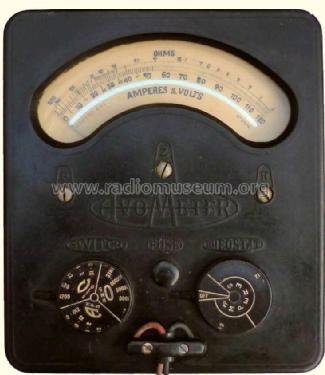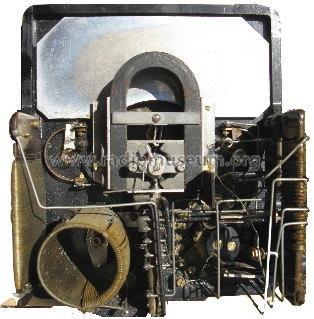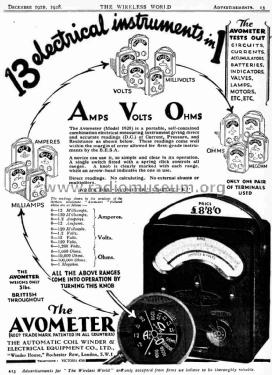AvoMeter (AVO Meter) 2
Avo (Brand), Automatic Coil Winder and Electrical Equipment Co., Avo Ltd; London
- Anno
- 1927 ??
- Categoria
- Strumento da laboratorio
- Radiomuseum.org ID
- 293874
- Gamme d'onda
- - senza
- Tensioni di funzionamento
- Batterie a secco
- Materiali
- Vari materiali
- Radiomuseum.org
- Modello: AvoMeter 2 - Avo Brand, Automatic Coil
- Annotazioni
-
The second version of the Avometer, has 13 ranges, DC only.
Bakelite front panel with an aluminum case.
DC Volts DC Amperes Resistance 0 - 120 mV 0 - 12 mA 0 - 1,000 Ω 0 - 1.2 V 0 - 120 mA 0 - 10,000 Ω 0 - 12 V 0 - 1.2 A 0 - 100,000 Ω 0 - 120 V 0 - 12 A 0 - 1 MΩ 0 -1,200 V
- Peso netto
- 5 lb (5 lb 0 oz) / 2.270 kg
- Prezzo nel primo anno
- 8.40 GB £
- Bibliografia
- Wireless World (The), London (WW, 79) (Dec 19, 1928, Page A13.)
- Autore
- Modello inviato da Gary Cowans. Utilizzare "Proponi modifica" per inviare ulteriori dati.
- Altri modelli
-
In questo link sono elencati 86 modelli, di cui 83 con immagini e 41 con schemi.
Elenco delle radio e altri apparecchi della Avo (Brand), Automatic Coil Winder and Electrical Equipment Co., Avo Ltd; London
Discussioni nel forum su questo modello: Avo Brand, Automatic: AvoMeter 2
Argomenti: 1 | Articoli: 1
AVOMETER.
Extracted from Wireless World, Feb 13, 1929, Page 187.
The 1928 model Avometer is a combination instrument designed and manufactured by the Automatic Coil Winder and Electrical Equipment Co., Ltd., Winder House, Rochester Row, London, S.W.1, for measuring D.C. currents, voltages, and also resistances, and covers the following ranges:-
| Current | Voltage | Resistance |
|---|---|---|
| 0 -12 A | 0 - 1,200 V | 0 - 1 MΩ |
| 0 -1.2 A | 0 - 120 V | 0 - 100,000 Ω |
| 0 -12 mA | 0 - 12 V | 0 - 10,000 Ω |
| 0 -12 mA | 0 - 1.2 V | 0 - 1,000 Ω |
| 0 - 120 mV |
The nucleus of the instrument consists of a spring-controlled moving coil pivoted on two polished steel points which are mounted in sapphire jewel bearings and swung in a powerful magnetic field generated by a cobalt steel magnet.
A knife-edged pointer is fitted to the moving coil, and this travels across a dial on which is engraved two scales approximately 5in, long. The upper scale is engraved 1,000 to 0, this being used for all resistance measurements, while the lower scale, which reads 0 - 120, is used for measuring current and voltage. The dial is provided with a mirror to facilitate the accurate reading of the pointer position.
The various ranges are brought into use by connecting suitable resistances either in series or shunt with the moving coil, these being controlled by a multi-point switch mounted on the front panel with the mechanical parts totally enclosed. The control for this switch is the left-hand knob on the front panel. To the right of this is another knob that operates a rheostat, this being intended as an auxiliary control for regulating the amount of current, if necessary, but does not affect the calibration of the instrument on the current ranges.
When used as an ohmmeter for measuring resistance values a 1½-volt cell, housed in a small compartment in the back of the instrument, is brought into use. This, however, is connected in circuit only when measurements coming within the scope of the two lower resistance ranges are being made. For the two higher ranges, i.e., 0 - 100,000 ohms and 0 - 1 megohm, an external battery of 7.5 volts or 75 volts should be connected in series with the resistance under test, the lower voltage is used for 100,000 ohm. range. Before commencing to take measurements of resistance on the two lower scales, it is advisable to check the meter to correct for any drop in voltage of the small 1½-volt cell.
Each instrument is provided with full instructions regarding the modus operandi, these being contained on a metal plate fixed to the back of the case. A few measurements were made on each range and checked against standard laboratory instruments; the degree of accuracy was found very satisfactory. For example, on the 120 mA range a current that the Avometer indicated as being 50 mA was measured on the standard instrument as 49.8, an error of plus 0.4 per cent., or of about the order of the thickness of the needle and as near as it is possible to read with the instrument under normal conditions.
Measurements on the 1.2 and 12-volt ranges were for all practical purposes identical to the readings obtained on our standard instruments and on the 120-volt range a small error of less than plus 1 percent. was recorded. Very careful measurements were made with an accurately adjusted resistance using the Avometer as an ohmmeter. By following the makers' instructions as regards the initial check before taking readings, the resistance as indicated by the Avometer agreed satisfactorily with the value found by the bridge method. When used as a voltmeter the resistance of the instrument is 167 ohms per volt, and a current of 6 milliamps is required for a full-scale deflection. It is, therefore, possible to utilise the 0.12 voltage range as a milliammeter if desired to measure very small current values, in which case the instrument will be twice as sensitive as if used on the 12 mA. scale. The external dimensions of the meter are 6½ in. X 4 in. X 7½ in., and the weight is 5 lb. The price is £8 8s., and for 15s. extra a strong leather carrying case with a handle and shoulder strap can be obtained.
Gary Cowans, 22.Oct.22


